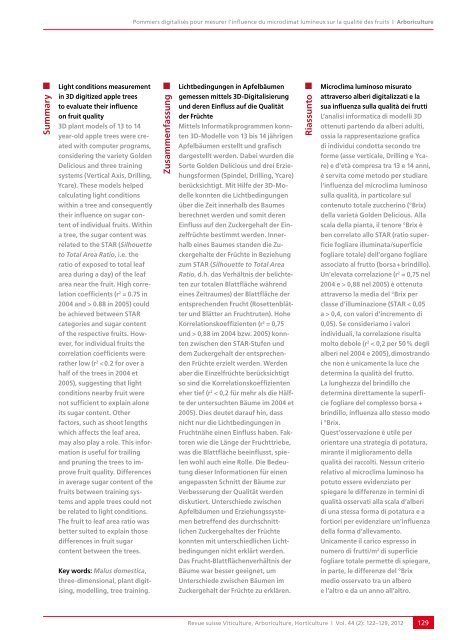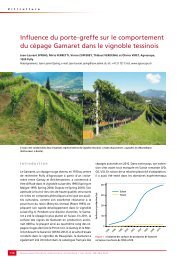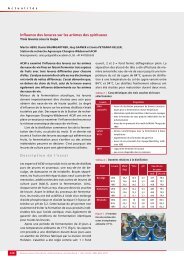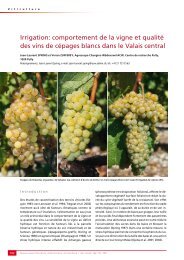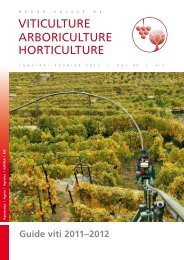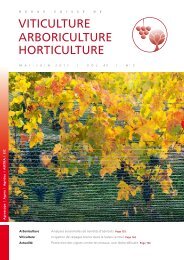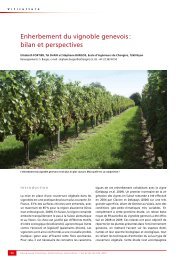Télécharger le PDF - Revue suisse de viticulture arboriculture ...
Télécharger le PDF - Revue suisse de viticulture arboriculture ...
Télécharger le PDF - Revue suisse de viticulture arboriculture ...
You also want an ePaper? Increase the reach of your titles
YUMPU automatically turns print PDFs into web optimized ePapers that Google loves.
Summary<br />
Light conditions measurement<br />
in 3D digitized app<strong>le</strong> trees<br />
to evaluate their influence<br />
on fruit quality<br />
3D plant mo<strong>de</strong>ls of 13 to 14<br />
year-old app<strong>le</strong> trees were created<br />
with computer programs,<br />
consi<strong>de</strong>ring the variety Gol<strong>de</strong>n<br />
Delicious and three training<br />
systems (Vertical Axis, Drilling,<br />
Ycare). These mo<strong>de</strong>ls helped<br />
calculating light conditions<br />
within a tree and consequently<br />
their influence on sugar content<br />
of individual fruits. Within<br />
a tree, the sugar content was<br />
related to the STAR (Silhouette<br />
to Total Area Ratio, i.e. the<br />
ratio of exposed to total <strong>le</strong>af<br />
area during a day) of the <strong>le</strong>af<br />
area near the fruit. High correlation<br />
coefficients (r 2 = 0.75 in<br />
2004 and > 0.88 in 2005) could<br />
be achieved between STAR<br />
categories and sugar content<br />
of the respective fruits. However,<br />
for individual fruits the<br />
correlation coefficients were<br />
rather low (r 2 < 0.2 for over a<br />
half of the trees in 2004 et<br />
2005), suggesting that light<br />
conditions nearby fruit were<br />
not sufficient to explain alone<br />
its sugar content. Other<br />
factors, such as shoot <strong>le</strong>ngths<br />
which affects the <strong>le</strong>af area,<br />
may also play a ro<strong>le</strong>. This information<br />
is useful for trailing<br />
and pruning the trees to improve<br />
fruit quality. Differences<br />
in average sugar content of the<br />
fruits between training systems<br />
and app<strong>le</strong> trees could not<br />
be related to light conditions.<br />
The fruit to <strong>le</strong>af area ratio was<br />
better suited to explain those<br />
differences in fruit sugar<br />
content between the trees.<br />
Key words: Malus domestica,<br />
three-dimensional, plant digitising,<br />
mo<strong>de</strong>lling, tree training.<br />
Pommiers digitalisés pour mesurer l’influence du microclimat lumineux sur la qualité <strong>de</strong>s fruits | Arboriculture<br />
Zusammenfassung<br />
Lichtbedingungen in Apfelbäumen<br />
gemessen mittels 3D-Digitalisierung<br />
und <strong>de</strong>ren Einfluss auf die Qualität<br />
<strong>de</strong>r Früchte<br />
Mittels Informatikprogrammen konnten<br />
3D-Mo<strong>de</strong>l<strong>le</strong> von 13 bis 14 jährigen<br />
Apfelbäumen erstellt und grafisch<br />
dargestellt wer<strong>de</strong>n. Dabei wur<strong>de</strong>n die<br />
Sorte Gol<strong>de</strong>n Delicious und drei Erziehungsformen<br />
(Spin<strong>de</strong>l, Drilling, Ycare)<br />
berücksichtigt. Mit Hilfe <strong>de</strong>r 3D-Mo<strong>de</strong>l<strong>le</strong><br />
konnten die Lichtbedingungen<br />
über die Zeit innerhalb <strong>de</strong>s Baumes<br />
berechnet wer<strong>de</strong>n und somit <strong>de</strong>ren<br />
Einfluss auf <strong>de</strong>n Zuckergehalt <strong>de</strong>r Einzelfrüchte<br />
bestimmt wer<strong>de</strong>n. Innerhalb<br />
eines Baumes stan<strong>de</strong>n die Zuckergehalte<br />
<strong>de</strong>r Früchte in Beziehung<br />
zum STAR (Silhouette to Total Area<br />
Ratio, d.h. das Verhältnis <strong>de</strong>r belichteten<br />
zur tota<strong>le</strong>n Blattfläche während<br />
eines Zeitraumes) <strong>de</strong>r Blattfläche <strong>de</strong>r<br />
entsprechen<strong>de</strong>n Frucht (Rosettenblätter<br />
und Blätter an Fruchtruten). Hohe<br />
Korrelationskoeffizienten (r 2 = 0,75<br />
und > 0,88 im 2004 bzw. 2005) konnten<br />
zwischen <strong>de</strong>n STAR-Stufen und<br />
<strong>de</strong>m Zuckergehalt <strong>de</strong>r entsprechen<strong>de</strong>n<br />
Früchte erzielt wer<strong>de</strong>n. Wer<strong>de</strong>n<br />
aber die Einzelfrüchte berücksichtigt<br />
so sind die Korrelationskoeffizienten<br />
eher tief (r 2 < 0,2 für mehr als die Hälfte<br />
<strong>de</strong>r untersuchten Bäume im 2004 et<br />
2005). Dies <strong>de</strong>utet darauf hin, dass<br />
nicht nur die Lichtbedingungen in<br />
Fruchtnähe einen Einfluss haben. Faktoren<br />
wie die Länge <strong>de</strong>r Fruchttriebe,<br />
was die Blattfläche beeinflusst, spie<strong>le</strong>n<br />
wohl auch eine Rol<strong>le</strong>. Die Be<strong>de</strong>utung<br />
dieser Informationen für einen<br />
angepassten Schnitt <strong>de</strong>r Bäume zur<br />
Verbesserung <strong>de</strong>r Qualität wer<strong>de</strong>n<br />
diskutiert. Unterschie<strong>de</strong> zwischen<br />
Apfelbäumen und Erziehungssystemen<br />
betreffend <strong>de</strong>s durchschnittlichen<br />
Zuckergehaltes <strong>de</strong>r Früchte<br />
konnten mit unterschiedlichen Lichtbedingungen<br />
nicht erklärt wer<strong>de</strong>n.<br />
Das Frucht-Blattflächenverhältnis <strong>de</strong>r<br />
Bäume war besser geeignet, um<br />
Unterschie<strong>de</strong> zwischen Bäumen im<br />
Zuckergehalt <strong>de</strong>r Früchte zu erklären.<br />
Riassunto<br />
Microclima luminoso misurato<br />
attraverso alberi digitalizzati e la<br />
sua influenza sulla qualità <strong>de</strong>i frutti<br />
L’analisi informatica di mo<strong>de</strong>lli 3D<br />
ottenuti partendo da alberi adulti,<br />
ossia la rappresentazione grafica<br />
di individui condotta secondo tre<br />
forme (asse vertica<strong>le</strong>, Drilling e Ycare)<br />
e d’età compresa tra 13 e 14 anni,<br />
è servita come metodo per studiare<br />
l’influenza <strong>de</strong>l microclima luminoso<br />
sulla qualità, in particolare sul<br />
contenuto tota<strong>le</strong> zuccherino (°Brix)<br />
<strong>de</strong>lla varietà Gol<strong>de</strong>n Delicious. Alla<br />
scala <strong>de</strong>lla pianta, il tenore °Brix è<br />
ben correlato allo STAR (ratio superficie<br />
fogliare illuminata/superficie<br />
fogliare tota<strong>le</strong>) <strong>de</strong>ll’organo fogliare<br />
associato al frutto (borsa + brindillo).<br />
Un’e<strong>le</strong>vata correlazione (r 2 = 0,75 nel<br />
2004 e > 0,88 nel 2005) è ottenuta<br />
attraverso la media <strong>de</strong>l °Brix per<br />
classe d’illuminazione (STAR < 0,05<br />
a > 0,4, con valori d’incremento di<br />
0,05). Se consi<strong>de</strong>riamo i valori<br />
individuali, la correlazione risulta<br />
molto <strong>de</strong>bo<strong>le</strong> (r 2 < 0,2 per 50 % <strong>de</strong>gli<br />
alberi nel 2004 e 2005), dimostrando<br />
che non è unicamente la luce che<br />
<strong>de</strong>termina la qualità <strong>de</strong>l frutto.<br />
La lunghezza <strong>de</strong>l brindillo che<br />
<strong>de</strong>termina direttamente la superficie<br />
fogliare <strong>de</strong>l comp<strong>le</strong>sso borsa +<br />
brindillo, influenza allo stesso modo<br />
i °Brix.<br />
Quest’osservazione è uti<strong>le</strong> per<br />
orientare una strategia di potatura,<br />
mirante il miglioramento <strong>de</strong>lla<br />
qualità <strong>de</strong>i raccolti. Nessun criterio<br />
relativo al microclima luminoso ha<br />
potuto essere evi<strong>de</strong>nziato per<br />
spiegare <strong>le</strong> differenze in termini di<br />
qualità osservati alla scala d’alberi<br />
di una stessa forma di potatura e a<br />
fortiori per evi<strong>de</strong>nziare un’influenza<br />
<strong>de</strong>lla forma d’al<strong>le</strong>vamento.<br />
Unicamente il carico espresso in<br />
numero di frutti/m 2 di superficie<br />
fogliare tota<strong>le</strong> permette di spiegare,<br />
in parte, <strong>le</strong> differenze <strong>de</strong>l °Brix<br />
medio osservato tra un albero<br />
e l’altro e da un anno all’altro.<br />
<strong>Revue</strong> <strong>suisse</strong> Viticulture, Arboriculture, Horticulture | Vol. 44 (2): 122–129, 2012 129


